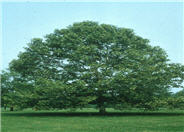
Common name:American Sycamore or Buttonwood
Botanical name:Platanus occidentalis
This beautiful deciduous tree rapidly reaches 75'-90' tall and 60'-70' wide. It starts out with a pyramidal habit and changes to a broad round crown later. Leaves are simple, green and can be 6"-10" long. Foliage turns yellow brown in fall. Red flowers appear in the spring but are not significant. The bark exfoliatesand can be reddish brown or gray. The peeling bark reveals a white inner bark. This tree needs moist, fertile, well-draining soil with full sun. Plant in large space areas such as parks.
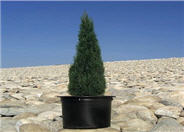
Common name:Tiny Towers Italian Cypress
Botanical name:Cupressus sempervirens 'Tiny Towers'
This tree will grow very slowly to 25' tall and 3' wide. It has dark green foliage with a lot of branches. The tree is upright, narrow, and very dense. It looks great in Mediterranean and formal gardens, also in containers. It tolerates ocean spray. Foliage is blue green. Use this plant as a windbreak. Once this plant is established, it is drought tolerant.
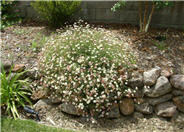
Common name:Santa Barbara Daisy, Mexican Daisy
Botanical name:Erigeron karvinskianus
This low mounding perennial, with fine leaves and white to pinkish, daisy-like flowers, is an excellent asset to rock gardens.
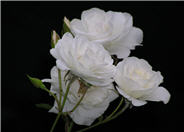
Common name:Iceberg Floribunda Rose
Botanical name:Rosa 'Iceberg'
This is a shrub rose (there are climbing varieties) with an abundance of fragrant, medium sized, white blooms. It is one of the most popular roses and very tough.
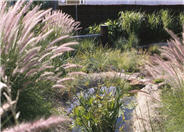
Common name:Fountain Grass
Botanical name:Pennisetum alopecuroides
Pennisetum alopecuroides is a perennial grass. Bright green, 3'-4' tall foliage clumps are topped by pinkish plumes in early summer. Leaves turn yellow in fall and brown in winter. Tall grasses are highly combustible.

Common name:Spanish Lavender
Botanical name:Lavandula stoechas
This dense shrub grows 2'-3' tall with blue gray foliage and deep purple flowers that have large showy bracts near the top of the spikes. It is drought tolerant . - Cornflower Farms
| Designer: | Retaining Rock Wall for Grass |
Photographer: GardenSoft |
Soils and Compost:
Incorporate compost 6" into your soil to retain water, reduce compaction, feed earthworms, and provide valuable nutrients to your plants.
Water Saving Tip:
Replace turf with groundcovers, trees, and shrubs. If you have areas where no one uses the grass, patches that do not grow well, or a turf area too small to water without runoff, consider replacing the turf with water-efficient landscaping.
Integrated Pest Management:
Remove irrigation water and fertilizer from areas where you don't want weeds to grow.

